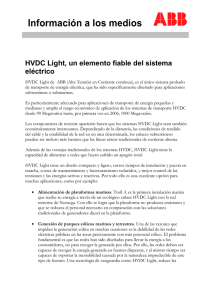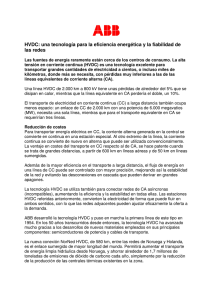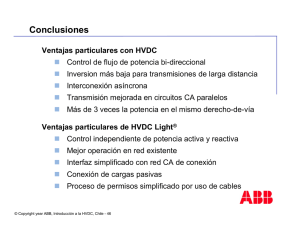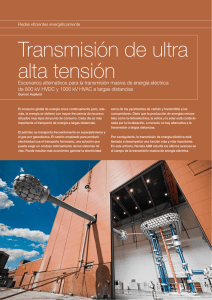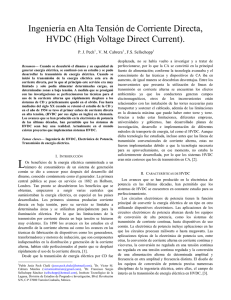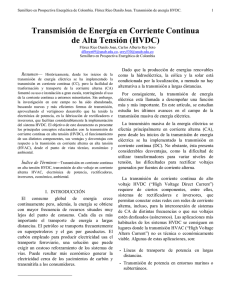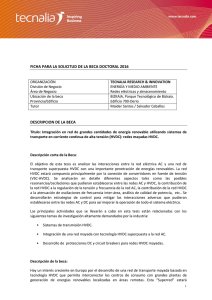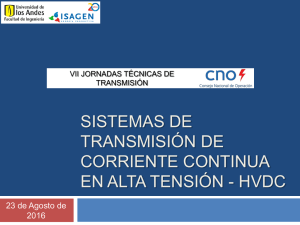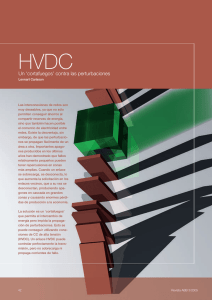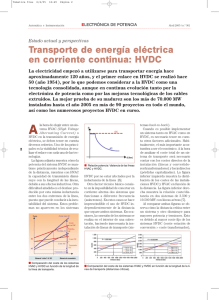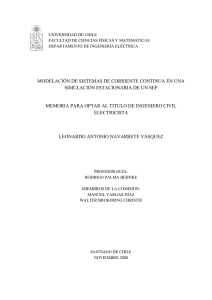CORRIENTE CONTINUA EN ALTA TENSIÓN (CCAT)
Anuncio
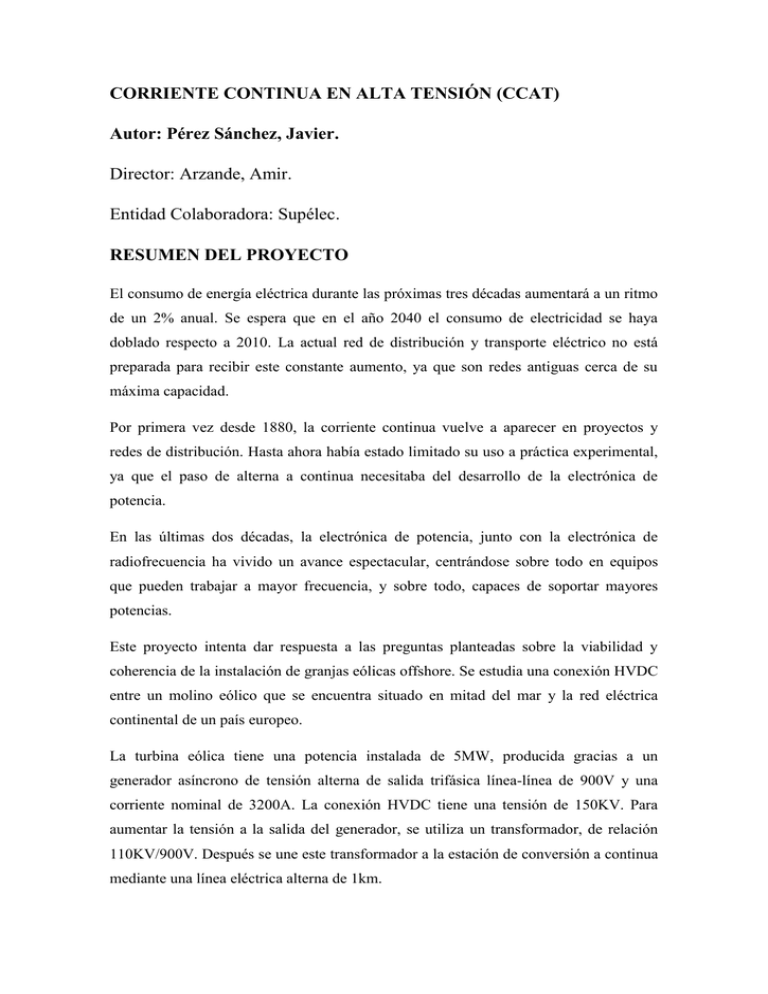
CORRIENTE CONTINUA EN ALTA TENSIÓN (CCAT) Autor: Pérez Sánchez, Javier. Director: Arzande, Amir. Entidad Colaboradora: Supélec. RESUMEN DEL PROYECTO El consumo de energía eléctrica durante las próximas tres décadas aumentará a un ritmo de un 2% anual. Se espera que en el año 2040 el consumo de electricidad se haya doblado respecto a 2010. La actual red de distribución y transporte eléctrico no está preparada para recibir este constante aumento, ya que son redes antiguas cerca de su máxima capacidad. Por primera vez desde 1880, la corriente continua vuelve a aparecer en proyectos y redes de distribución. Hasta ahora había estado limitado su uso a práctica experimental, ya que el paso de alterna a continua necesitaba del desarrollo de la electrónica de potencia. En las últimas dos décadas, la electrónica de potencia, junto con la electrónica de radiofrecuencia ha vivido un avance espectacular, centrándose sobre todo en equipos que pueden trabajar a mayor frecuencia, y sobre todo, capaces de soportar mayores potencias. Este proyecto intenta dar respuesta a las preguntas planteadas sobre la viabilidad y coherencia de la instalación de granjas eólicas offshore. Se estudia una conexión HVDC entre un molino eólico que se encuentra situado en mitad del mar y la red eléctrica continental de un país europeo. La turbina eólica tiene una potencia instalada de 5MW, producida gracias a un generador asíncrono de tensión alterna de salida trifásica línea-línea de 900V y una corriente nominal de 3200A. La conexión HVDC tiene una tensión de 150KV. Para aumentar la tensión a la salida del generador, se utiliza un transformador, de relación 110KV/900V. Después se une este transformador a la estación de conversión a continua mediante una línea eléctrica alterna de 1km. Los convertidores entre corriente continua y corriente alterna son convertidores controlados por tensión o VSC (Voltage-Sourced Converter). El desarrollo de estos convertidores ha sido posible gracias al desarrollo de los transistores bipolares de puerta aislada, o IGBT (Insulated-Gate Bipolar Transistor). El paso de corriente continua se realizará a través de un cable XLPE para valores de tensión máxima 150KV y una distancia estimada entre estaciones HVDC de 250 km. Este cable tendrá un polo más el retorno en neutro. A su vez, un cable de corriente alterna de longitud 1 km unirá la turbina a la estación HVDC. Este cable trifásico tendrá las mismas características que el cable de corriente continua. Tras la conversión de nuevo a corriente alterna, el modelo será conectado a una carga o resistencia que hará las veces de red eléctrica. Esta solución ha sido tomada ya que los modelos necesarios para sincronizar y unir dos redes trifásicas alternas son dignos por si solos de un proyecto aparte. Pero esta solución no es del todo satisfactoria, ya que para obtener una correcta señal sinusoidal es necesario disponer de una red trifásica de referencia. Es por ello, y por la ausencia de filtros de harmónicos que las corrientes de salida no son perfectamente sinusoidales. Aun así, los resultados obtenidos en las simulaciones muestran que la corriente continua tiene menores perdidas que la corriente alterna. Además la tecnología HVDC permite transporta mayor cantidad de energía que la HVAC, ya que el voltaje es constante, al igual que la corriente, transmitiendo siempre el máximo de potencia disponible. Faltaría estudiar el efecto que tiene filtros de paso bajo, para frecuencias de producción de la energía eléctrica (50-60Hz). Es importante recordar que estos filtros ayudan no solo a emitir una onda correcta sinusoidal, sino también a mejorar el factor de potencia de la red a la que esté conectada la granja eólica. Teniendo en cuenta todas las ventajas enumeradas, es pregunta obligada por qué el desarrollo del transporte eléctrico no ha sido realizado en HVDC hasta hace relativamente poco. Cabe decir como respuesta que el coste de los convertidores es muy alto, ya que necesitan de tecnología avanzada y solo se han obtenido componentes fiables en los últimos tiempos. Este coste en la mayoría de las veces no compensa las mayores pérdidas de una línea HVAC. No obstante la distancia entre costes se reduce cada día más, ya que el avance constante de la electrónica de potencia ha reducido los costes de las estaciones, aumentando su competitividad en distancias más cortas. De manera general, para líneas aéreas, la intersección entre el coste de HVDC y HVAC se encuentra alrededor de 400 km de distancia entre el punto de generación y el punto de consumo. Para caso de líneas submarinas, esta distancia se reduce debido a la mayor inductancia existente en los cables submarinos por haber una capa mayor de aislante. La distancia queda fijada a 80km, que es una distancia inferior a la mayoría de las conexiones importantes bajo estudio (Irlanda-Inglaterra-Europa Continental) o que ya han sido realizadas (Península Ibérica-Menorca). Este estudio quiere poner de relieve la importancia que tienen y tendrán las líneas HVDC en el futuro próximo de la energía eléctrica. Nuevas conexiones que ayudarán a estabilizar y mejorar el sistema eléctrico mundial están bajo estudio. También ayudarán a controlar e integrar el desarrollo de las energías renovables, que no tienen una producción estable ni son predecibles en periodos largos de tiempo. La política europea de energía ya ha comenzado a hablar de una red internacional que conectaría Europa, el norte de África y los futuros parques eólicos que se están instalando en la costa irlandesa y en el mar del Norte. La tecnología en corriente continua en alta tensión permite que todas estas conexiones sean ser reversibles, fácilmente controlables y de alta capacidad. Son capaces de transportar la capacidad de generación de granjas eólicas o solares en largas y muy largas distancias, sin sufrir excesivas pérdidas ni de potencia ni de tensión. Se puede resumir que la tecnología de Corriente Continua en Alto Voltaje puede ayudar a alcanzar el sueño del autoabastecimiento energético de Europa, y la independencia de los países productores de petróleo o gas. Este último punto entra en relieve si se echa la vista atrás, a las últimas crisis energéticas acaecidas en los últimos meses como son el desafío de Rusia en Ucrania, los brotes de guerra civil en Irak, y el avance del Estado Islámico de Irak y el Levante, que puede afectar a la producción de petróleo en Oriente Medio y Próximo. HIGH VOLTAGE DIRECT CURRENT The energy consumption for the next three decades will increase at a rate of 2% per year. It is expected that in 2040 electricity consumption has doubled over 2010's. Current electrical transport and distribution network are not ready for this steady increase, as older networks are near their maximum capacity. For the first time since 1880, direct current reappears in projects and transport networks. Until now, direct current has been limited to experimental use. The passage from AC to DC needed for the development of power electronics. In the past two decades, power electronics, along with radio frequency electronics have seen an important improvement, focusing especially on equipment and transistors that can operate at higher frequency, and above all, equipment that are able to withstand higher powers. This project attempts to answer the questions raised about the feasibility and consistency of the installation of offshore wind farms. A HVDC connection between a wind turbine that is located in the middle of the sea and the continental power grid is studied. The wind turbine has an installed capacity of 5 MW, produced by an asynchronous generator with three phase output AC voltage of 900V line-line and a nominal current of 3200A. HVDC connection has a voltage of 150KV. To increase the output voltage of the generator, a transformer is used with 110KV/900V relationship. Transformer output is attached to the conversion station by a 1km AC power line. Converters between direct current and alternating current are controlled by voltage and Pulse Width Modulation, named VSC (Voltage-Sourced Converters). The development of these converters has been possible thanks to research of insulated gate bipolar transistor or IGBT. The current transport is performed through a XLPE cable for high voltage (150KV). Between HVDC stations the length is 250 km. This cable will have one pole and a neutral return. Also a 1km AC three-phase cable connects the HVDC station and the transformer. After the conversion back to AC power, the model will be connected to a load or resistance that will act as the three-phase national grid. This solution has been taken as the models needed to synchronize and merge two alternating phase networks are by themselves worthy of a separate project. But this solution is not entirely satisfactory, since part of the needs for the correct operation of the converters is to provide a reference phase network. Therefore, the absence of harmonic filters avoids the output currents to be perfectly sinusoidal. Even so, the results of the simulations show that DC has lower losses than AC. After more, HVDC technology allows to transport more power, as the voltage and the current are constant, so the power transport is maximized. Missing the study of the effect of low-pass filters for electricity production frequencies (50-60Hz), it is important to remember that these filters not only help to issue a proper sine wave, but to improve power factor of the network. Considering all the advantages listed, we must ask why the development of electric transport has not been done in HVDC until relatively recently. It must be said in response that the cost of the converters is very high as they need advanced technology and it has been reliable only in recent times. This cost does not offset the higher losses of HVAC line in short lines. But the gap between costs is reduced every day, due to constant advancement of power electronics, which has reduced the cost of these stations, increasing its competitiveness at shorter distances. Generally, for terrestrial power lines, the intersection between the cost of HVDC and HVAC is about 400 km from the point of generation to the point of consumption. For the case of submarine lines, this distance is reduced due to the effect of the inductance of the cable. Subsea cables need greater insulation. The distance is fixed at 80km, a distance less than the most important connections under study (IrelandEngland-Continental Europe) or that have already been built (Menorca-Spain). This study aims to highlight the importance HVDC lines will have in the near future of electricity. New connections to help stabilize and improve the global electricity system are under study. Also they will help to control and integrate the development of renewable energy, which has an unstable and unpredictable long-time production. The European energy policy has already begun to speak of an international network that would connect Europe, North Africa, and future wind farms being installed in both the Irish coast and North Sea. HVDC allows that the different connections would be reversible, easily controllable and with high capacity. They are therefore capable of carrying the power generates by wind or solar farms. Long distances would not be a problem, not suffering excessive losses of power or voltage. Therefore it can be summarized that High Voltage Direct Current can help achieve the dream of energy self-sufficiency and the independence of petrol producers. This last point comes embossed with latest energy crises in recent months such as the challenge of Russia in Ukraine, outbreaks of civil war in Iraq, and the advancement of the Islamic State of Iraq and the Levant, which may affect the oil production in the Middle and Near East.
